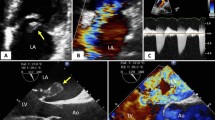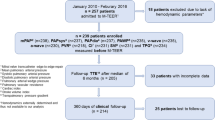Abstract
Purpose of Review
This review aims to delineate the actual role of percutaneous intervention in the closure of post-myocardial infarction ventricular septal defect (post-MI VSD) and to briefly summarize the main steps of this procedure.
Recent Findings
Most of the published studies report experiences using Amplatzer devices for post-MI VSD closure. In the acute phase, morbidity and mortality are quite high up to 70%, with a mean success rate of 90%, with 95% confidence intervals from 60 to 100%, and a 30-day mortality of 40%, with 95% confidence intervals from 0 to 55%. In the chronic phase, that is 14 days after myocardial infarction, results are very encouraging, with lower morbidity and mortality (23% at 30 days) and a higher rate of complete closure. A multimodality imaging approach has been proposed in order to increase the success rate of this procedure.
Summary
Percutaneous closure is a safe and effective procedure in highly specialized centers and an appropriate patient selection is of paramount importance to the success of the procedure. Device closure of post-MI VSD can be considered a true alternative to the standard surgical approach. However, many problems still exist for percutaneous post-MI VSD treatment.

Similar content being viewed by others
References
Papers of particular interest, published recently, have been highlighted as: • Of importance •• Of major importance
Crenshaw BS, Granger CB, Birnbaum Y, for the GUSTO-I Trial Investigators. Risk factors, angiographic patterns, and outcomes in patients with ventricular septal defect complicating acute myocardial infarction. Circulation 2000; 101: 27–32.
Omar S, Morgan GL, Panchal HB, Thourani V, Rihal CS, Patel R, et al. Management of post-myocardial infarction ventricular septal defects: a critical assessment. J Interv Cardiol. 2018;31(6):939–48.
Menon V, Webb JG, Hillis LD, Sleeper LA, Abboud R, Dzavik V, et al. Outcome and profile of ventricular septal rupture with cardiogenic shock after myocardial infarction. A report from the SHOCK Trial Registry. Should we emergently revascularize occluded coronaries in cardiogenic shock? J Am Coll Cardiol. 2000;36:1110–6.
Labrousse L, Choukroun E, Chevalier JM, Madonna F, Robertie F, Merlico F, et al. Surgery for post infarction ventricular septal defect: risk factors for hospital death and long term results. Eur J Cardiothorac Surg. 2002;21:725–31.
Papadopoulos N, Moritz A, Dzemali O, Zierer A, Rouhollapour A, A Ackermann H, Bakhtiary F. Long-term results after surgical repair of postinfarction ventricular septal rupture by infarct exclusion technique. Ann Thorac Surg 2009; 87:1421–1425.
Cerin G, Di Donato M, Dimulescu D, Montericcio V, Menicanti L, Frigiola A, et al. Surgical treatment of ventricular septal defects complicating acute myocardial infarction. Experience of a north Italian referral hospital. Cardiovascular Surg. 2003;11:149–54.
•• Ibanez B, James S, Agewall S, Antunes MJ, Bucciarelli-Ducci C, Bueno H, et al; ESC Scientific Document Group. 2017 ESC guidelines for the management of acute myocardial infarction in patients presenting with ST-segment elevation: the task force for the management of acute myocardial infarction in patients presenting with ST-segment elevation of the European Society of Cardiology (ESC). Eur Heart J 2018;39(2):119–177. ESC guidelines assess that there is no consensus on the optimal timing of post-MI VSD surgical closure.
Arnaoutakis GJ, Zhao Y, George TJ, Sciortino CM, McCarthy PM, Conte JV. Surgical repair of ventricular septal defect after myocardial infarction: outcomes from the society of thoracic surgeons national database. Ann Thorac Surg. 2012;94(2):436–44.
Malhotra A, Patel K, Sharma P, Wadhawa V, Madan T, Khandeparkar J, et al. Techniques, timing & prognosis of post infarct ventricular septal repair: a re-look at old dogmas. Braz J Cardiovasc Surg. 2017;32(3):147–55.
Barker TA, Ramnarine IR, Woo EB, Grayson AD, Au J, Fabri BM, et al. Repair of post-infarct ventricular septal defect with or without coronary artery bypass grafting in the northwest of England: a 5-year multi-institutional experience. Europ J Cardio-thorac Surgery. 2003;24:940–6.
Perrotta S, Lentini S. In patients undergoing surgical repair of post-infarction ventricular septal defect, does concomitant revascularization improve prognosis? Interactive Cardiovascular Thoracic Surg. 2009;9:979–87.
• McLaughlin A, McGiffin D, Winearls J, Tesar P, Cole C, Vallely M, et al. Veno-arterial ECMO in the setting of post-infarct ventricular septal defect: a bridge to surgical repair. Heart Lung Circ. 2016;25(11):1063–6 This paper highlights the emerging role of ECMO in post-MI VSD management.
Lock JE, Block PC, McKay RG, Baim DS, Keane JF. Transcatheter closure of ventricular septal defects. Circulation. 1988;78:361–8.
Elasfar AA, Soofi MA, Kashour TS, Koudieh M, Galal MO. Transcatheter closure of residual postinfarction ventricular septal defect after dehiscence of surgical patch repair. Ann Saudi Med. 2014;34(2):171–4.
Barik R. Transcatheter closure of post-myocardial infarction ventricular defect: where are we? Indian Heart J. 2016;68(1):99–101.
Holzer R, Balzer D, Amin Z, Balzer D, Amin Z, Ruiz CE, et al. Transcatheter closure of postinfarction ventricular septal defects using the new Amplatzer muscular ventricular septal defect occluder: results of a US registry. Cathet Cardiovasc Interv. 2004;61:196–201.
Szkutnik M, Bialkowski J, Kusa J, Banaszak P, Baranowski J, Gasior M, et al. Postinfarction ventricular septal defect closure with Amplatzer occluders. Eur J Cardiothorac Surg. 2003;23:323–7.
Chessa M, Carminati M, Cao QL, Butera G, Giusti S, Bini RM, et al. Transcatheter closure of congenital and acquired muscular ventricular septal defects using the Amplatzer device. J Invasive Cardiol. 2002;14(6):322–7.
Bialkowski J, Szkutnik M, Kusa J, Kalarus Z, Gasior M, Przybylski R, et al. Transcatheter closure of postinfarction ventricular septal defects using Amplatzer devices. Rev Esp Cardiol. 2007;60:548–51.
Shabestari MM, Ghaderi F, Hamedanchi A. Transcatheter closure of postinfarction ventricular septal defect: a case report and review of literature. J Cardiovasc Thorac Res. 2015;7(2):75–7.
Butera G, Castaldi B, McDonald ST. Over the wire technique device implantation. Catheter Cardiovasc Interv. 2012;80(3):485–92.
Butera G, Lovin N, Basile DP, Carminati M. Goose-neck snare-assisted transcatheter ASD closure: a safety procedure for large and complex ASDs. Catheter Cardiovasc Interv. 2016;87(5):926–30.
Arias EA, Bhan A, Lim ZY, Mullen M. Utility of the Gore septal occluder in transcatheter closure of post-myocardial infarct ventricular septal defect. JACC Cardiovasc Interv. 2016;9(21):2259–61.
Sabiniewicz R, Huczek Z, Zbroński K, Scisło P, Rymuza B, Kochman J, et al. Percutaneous closure of post-infarction ventricular septal defects—an over decade-long experience. J Interv Cardiol. 2017;30(1):63–71.
Shahreyar M, Akinseye O, Nayyar M, Ashraf U, Ibebuogu UN. Post-myocardial infarction ventricular septal defect: a comprehensive review. Cardiovasc Revasc Med. 2018.
Schlotter F, de Waha S, Eitel I, Desch S, Fuernau G, Thiele H. Interventional post-myocardial infarction ventricular septal defect closure: a systematic review of current evidence. EuroIntervention. 2016;12(1):94–102.
Rao DS, Barik R, Siva Prasad A. Hemolysis induced by PMIVSD occluder. Indian Heart J. 2016;68(Suppl 2):S60–3.
Kafes H, Ozeke O, Demirkan B, Acar B, Aysenur Ekizler F, Karabulut O, et al. Flail tricuspid leaflet during the percutaneous closure of post-myocardial infarction ventricular septal defect. CASE (Phila). 2017;1(5):207–9.
Goldstein JA, Casserly IP, Balzer DT, Lee R, Lasala JM. Transcatheter closure of recurrent postmyocardial infarction ventricular septal defects utilizing the Amplatzer postinfarction ventricular septal defect device: a case series. Catheter Cardiovasc Interv. 2003;59:238–43.
Aggarwal M, Natarajan K, Vijayakumar M, Chandrasekhar R, Mathew N, Vijan V, et al. Primary transcatheter closure of post-myocardial infarction ventricular septal rupture using Amplatzer atrial septal occlusion device: a study from tertiary care in South India. Indian Heart J. 2018;70(4):519–27.
Thiele H, Kaulfersch C, Daenhert I, Schoenauer M, Eitel I, Borger M, et al. Immediate primary transcatheter closure of postinfarction ventricular septal defects. Eur Heart J. 2009;30:81–8.
Martinez MW, Mookadam F, Sun Y, Hagler DJ. Transcatheter closure of ischemic and post-traumatic ventricular septal ruptures. Catheter Cardiovasc Interv. 2007;69:403–7.
Ahmed J, Ruygrok PN, Wilson NJ, Webster MWI, Greaves S, Gerber I. Percutaneous closure of post-myocardial infarction ventricular septal defects: a single centre experience. Heart, Lung Cir. 2008;17:119–23.
Egbe AC, Poterucha JT, Rihal CS, Taggart NW, Cetta F, Cabalka AK, et al. Transcatheter closure of postmyocardial infarction, iatrogenic, and postoperative ventricular septal defects: the mayo clinic experience. Catheter Cardiovasc Interv. 2015;86:1264–70.
• Hamilton MCK, Rodrigues JCL, Martin RP, Manghat NE, Turner MS. The in vivo morphology of post-infarct ventricular septal defect and the implications for closure. JACC Cardiovasc Interv. 2017;10(12):1233–43 This paper describes the post-MI VSD morphology and explains possible difficulties in VSD closure related to such different shapes.
Iyer S, Bauer T, Yeung M, Ramm C, Kiser AC, Caranasos TG, et al. A heart team and multi-modality imaging approach to percutaneous closure of a post-myocardial infarction ventricular septal defect. Cardiovasc Diagn Ther. 2016;6(2):180–4.
Author information
Authors and Affiliations
Corresponding author
Ethics declarations
Conflict of Interest
Alessia Faccini declares no conflict of interest. Gianfranco Butera is a proctor for Abbott.
Human and Animal Rights and Informed Consent
This article does not contain any studies with human or animal subjects performed by any of the authors.
Additional information
Publisher’s Note
Springer Nature remains neutral with regard to jurisdictional claims in published maps and institutional affiliations.
This article is part of the Topical Collection on Structural Heart Disease
Rights and permissions
About this article
Cite this article
Faccini, A., Butera, G. Techniques, Timing, and Prognosis of Transcatheter Post Myocardial Infarction Ventricular Septal Defect Repair. Curr Cardiol Rep 21, 59 (2019). https://doi.org/10.1007/s11886-019-1142-8
Published:
DOI: https://doi.org/10.1007/s11886-019-1142-8




